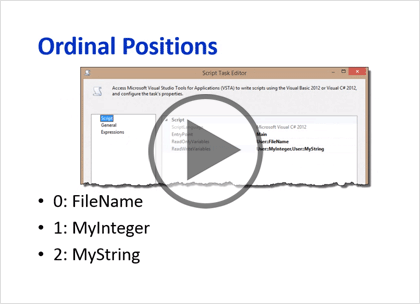Course description
You can add script to an Integration Services package in two main ways, both of which you’ll learn about in this course. First you’ll learn how to use the Script task to add script to a package’s Control Flow. Then you’ll learn how to use the Script Component to add script to a package’s Data Flow. These two components are quite different. The Script task usually executes once in the package, or perhaps once per loop in a looping container. The Script Component executes once per row in the Data Flow, and may end up executing millions of times each time the package executes if there is that much data to process. This is why there are separate components for the Control and Data Flows: the requirements of each are quite different. As a result, the code you’ll write for each is quite different, as you’ll learn in this course.
Prerequisites
This course assumes that you have a basic familiarity with the concept of relational databases and a basic understanding of what SQL Server is and the high-level tools in it, as well as how to create and manage objects using Management Studio. You should also have a basic understanding of how SQL Server implements security, including its authentication and authorization schemes, and how to assign permissions on securable objects to principals. You should know the fundamentals of Transact-SQL to write queries to retrieve data and join data from multiple tables, and how to execute scripts using the query editor in Management Studio. You must also know how to connect to an instance of SQL Server 2012 or 2014 using the various connection dialog boxes in Management Studio and development tools. It will be very helpful, but not absolutely necessary, to have experience with .NET development using Visual Studio 2013 or later for the portions of the course that deal with SQL Server Data Tools (which is a lot of it). At the very least, we’ll assume that you are well familiar with the Visual Studio user interface. This course assumes no prior knowledge of SQL Server Integration Services beyond what is covered in the previous SSIS courses.
Learning Paths
This course will help you prepare for the following certifications and exams:
MCSE: Business Intelligence
MCSA: SQL Server 2012/2014
MCSE: Data Platform
70-467: Designing Business Intelligence Solutions with Microsoft SQL Server
70-463: Implementing a Data Warehouse with Microsoft SQL Server 2012/2014
This course is part of the following LearnNowOnline SuccessPaths™:
SQL Server Integration Services
Meet the expert
Don Kiely is a featured instructor on many of our SQL Server and Visual Studio courses. He is a nationally recognized author, instructor, and consultant specializing in Microsoft technologies. Don has many years of teaching experience, is the author or co-author of several programming books, and has spoken at many industry conferences and user groups. In addition, Don is a consultant for a variety of companies that develop distributed applications for public and private organizations.
Course outline
Scripting Components
Extending Through Code (19:22)
- Introduction (00:45)
- Integration Services Scripting (02:17)
- Custom Component Development (01:15)
- Integration Services Scripting 2 (02:10)
- When to Use IS Scripting? (03:11)
- When NOT to Use IS Scripting? (04:07)
- IS Object Model (05:06)
- Summary (00:28)
VSTA Application Script Editor (14:38)
- Introduction (01:15)
- Demo: A Simple IS Project (04:57)
- Demo: Configuring Script Task (03:52)
- Demo: Executing a Script Task (03:57)
- Summary (00:34)
Control Flows with Script Task (11:36)
- Introduction (00:30)
- Scripting in Control Flows (03:05)
- Variables (00:22)
- Variable Collection (01:25)
- Accessing Variables (01:59)
- Ordinals Positions (01:35)
- VariableDispenser Object (01:10)
- VariableDispenser Example (00:59)
- Summary (00:27)
Script Task Demo (16:30)
- Introduction (00:20)
- Demo: Creating Variables (04:23)
- Demo: Development Environment (04:13)
- Demo: Add More Script Tasks (04:34)
- Going Beyond Built-In Tasks (02:24)
- Summary (00:34)
Dataflows (20:21)
- Introduction (01:05)
- The Script Component (02:33)
- Input & Output Columns (03:04)
- Script Component Types (00:39)
- Script Component - Source (02:18)
- Script Component - Destination (01:36)
- Script Comp – Transformation (01:43)
- Synchronous vs Asynchronous (01:00)
- Transformation Synchronicity (01:22)
- Script Component Synchronicity (01:48)
- Asynchronous Transform Types (00:42)
- Building Async Transformations (01:35)
- Summary (00:52)
Script Component Demo (20:44)
- Introduction (00:27)
- Demo: Create Script Component (04:36)
- Demo: Configure the Component (03:45)
- Demo: The VSTA Environment (04:44)
- Demo: Execute Flow Task (05:13)
- Going Beyond Built-In Data Flow (01:20)
- Summary (00:37)



